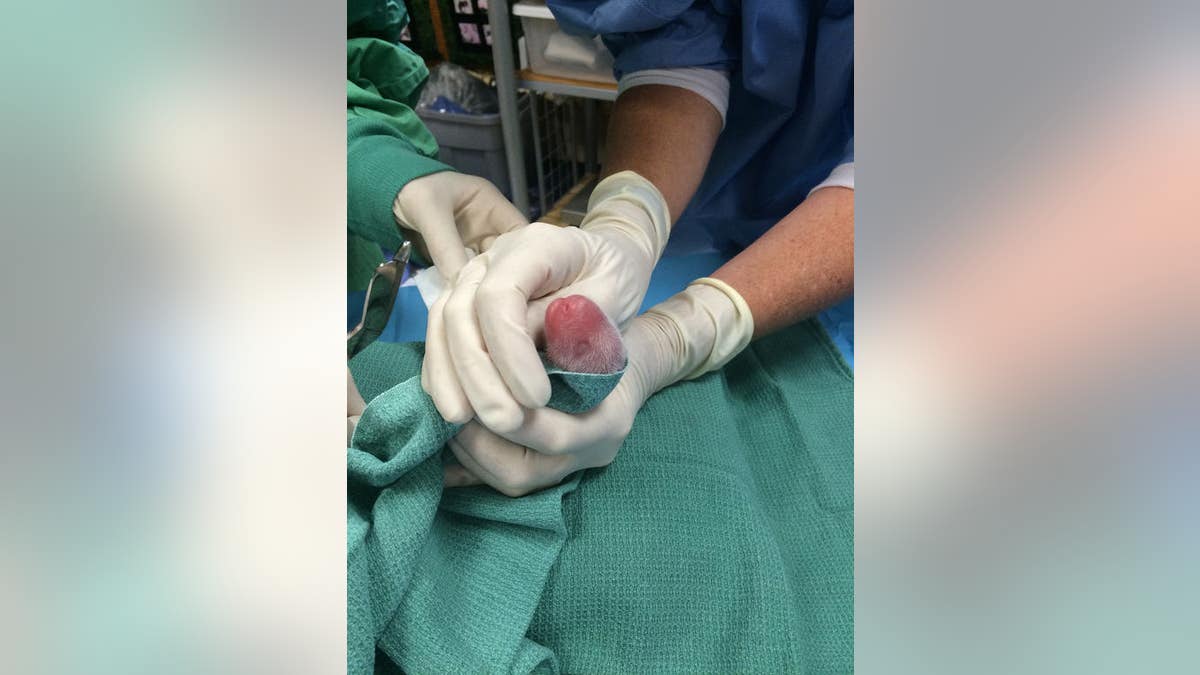
Veterinarians swaddle and examine the first-retrieved cub. Its sex won't be determined until a later date. (Becky Malinsky/Smithsonian's National Zoo)
Zookeepers are playing a complicated game of "baby swap" with two new pink and fuzzy panda twins at the Smithsonian's National Zoo in Washington, D.C.
The mother, 17-year-old Mei Xiang (may-SHONG), gave birth to the twins Aug. 22, delivering the first at 5:35 p.m. ET and the second at 10:07 p.m., the zoo reported.
But giant pandas (Ailuropoda melanoleuca) can care for only one cub at a time. The mother isn't able to pick up both cubs simultaneously, meaning one cub would have stayed on the floor and gotten cold, said Laurie Thompson, a giant panda biologist at the zoo. [See Photos of Mei Xiang's New Twin Panda Cubs]
"It wouldn't have made it," Thompson told Live Science. "These [newborn cubs] can't regulate their temperature."
So, zookeepers retrieved one of the cubs and placed in it an incubator, while the other snuggled with its mom, Thompson said.
The cub the zookeepers retrieved, which they believe is the second born, appears healthy, the zoo officials said. On Sunday morning, it weighed 0.3 lbs. and has been able to vocalize (it sounds like a squeaky toy), urinate and defecate — all signs that it's doing well. Zoo staff also removed the cub's umbilical cord and fed the cub a special serum with antibodies to help develop its immune system, Thompson told Live Science.
After the exam, the panda team successfully swapped the cubs, giving the second-born time to bond with its mother. After they whisked the firstborn back to the exam room, they found that it weighed about 0.2 lbs. and is able to squeak like its twin.
The zookeepers plan to swap the cubs every 3 to 4 hours, giving the newborns time to rest and nurse with Mei Xiang before returning to the incubator.
Baby swap
Mei Xiang usually keeps her cubs warm by tucking them under her arm, Thompson said. (She's given birth to six cubs, including the new duo, though two didn't survive.)
"You know how babies like to be in those little snuggly things? It's the same for these panda cubs," Thompson said. "They'll tuck them in somewhere where it's nice and warm and hold them under their armpit. When she needs to nurse, it's kind of close to that position, so it doesn't have to go very far."
But switching out the cubs isn't always easy; the zookeepers can get close to the mama bear, but they can't actually enter the panda's den, for safety reasons.
Sometimes a zookeeper will place a cub on the ground in Mei Xiang's den. Once the cub starts to cry, "She hears the crying baby and puts down the one she was holding," so she can pick up the new cub, Thompson said. The zookeepers then grab the other cub and place it in the incubator.
Other times, if Mei Xiang is near the edge of the den, zookeepers can reach down, lift the cub off of its mother and quickly replace it with the twin.
"[Mei Xiang] is kind of in a post-birth stupor," Thompson said. "Normally you would never reach in and do something like that with a panda. But because all of their energy is going into taking care of the cub, they really are in this state of not really being aware of what's going on."[Cute Alert! Adorable Photos of Giant Panda Triplets]
Sometimes Mei Xiang doesn't want to be bothered, so she'll move away from the edge to a place where the zookeepers can't reach her, Thompson said.
"If Mei Xiang is not cooperating, then we'll wait longer and try again," Thompson said. "But she's been amazingly cooperative, considering."
When the cubs are in the incubator, zoo staff feed them with formula made of water, human baby formula and puppy formula, Thompson said.
What's next?
Once the cubs are stronger, zoo staff will take a salvia swab from each so geneticists can determine each cub's sex and father. (Panda twins can have different fathers.) When veterinarians gave Mei Xiang artificial insemination in April, they used semen from Hui Hui (h-WEI h-WEI), a panda living in the China Conservation and Research Center for the Giant Panda in Sichuan, China, and Tian Tian (t-YEN t-YEN), a male giant panda at the National Zoo.
The pandas will receive names if they make it to the 100-day mark, Thompson said. Why the long wait for a name? For panda naming, U.S. zoos follow a Chinese tradition of waiting 100 days to name human babies. All pandas belong to China and are on loan to the United States and other foreign zoos.
In addition, the cubs don't always make it; in 2012, a cub at the National Zoo died from liver damage when it was just 6 days old, likely because its lungs were underdeveloped.
If the twins continue to do well, zookeepers hope to allow them to spend time with Mei Xiang together.
Giant pandas give birth to twins about 50 percent of the time, but this is only the third time a giant panda in the United States has delivered twins, the zoo said. There are just two other female giant pandas in the world that have successfully reared twins, and those feats have required plenty of human support, the zoo said.
People interested in watching Mei Xiang and her twins can tune in to the panda cam online or download the Smithsonian's National Zoo app for $1.99.
- In Photos: Giant Panda Mei Xiang Gives Birth
- Baby Panda Pics: See A Cub Growing Up
- Photos: World's Cutest Baby Wild Animals
Copyright 2015 LiveScience, a Purch company. All rights reserved. This material may not be published, broadcast, rewritten or redistributed.
